
Original Link: https://www.anandtech.com/show/2612
NVIDIA 9500 GT: Mainstream Graphics Update
by Derek Wilson on September 5, 2008 10:15 PM EST- Posted in
- GPUs
Even though sub $100 hardware is very high volume, we don't often see a lot of heated debate surrounding them. People don't usually get excited about mainstream and low end hardware. The battle for who can run the newest game with the coolest effects at the highest resolution, while not applicable to most people, tends to generate quite a bit of interest. There is a lot of brand loyalty in this industry, and people like to see the horse they backed come out on top. Others, while not siding with a particular company, jump on the wagon with what ever company has the fastest part at any given time. I, myself, am a fan of the fastest hardware out at any given time. I get excited by how far we've come, and how much closer the top of the line gets us to the next step. Keeping up with top of the line hardware is more like attending a sporting event or taking in a play: the struggle itself is entertainment value.
For some, knowing what's best does have relevance. For many many others, it is more important for to keep track of hardware that, while cheap, is as capable as possible. And that is where we are today.
At the end of July, NVIDIA released their GeForce 9500 GT. This part (well, the GDDR3 version anyway) is almost a drop in replacement for the 8600 GT as far as the specifications go. In fact, the prices are nearly the same as well.
No, it isn't that exciting. But even these very low end add in cards are head and feet above integrated graphics solutions. While we'd love to see everything get more performance, the price of the 8600 GT has dropped significantly over time. We haven't gotten to a point where people who aren't willing or able to spend above $100 on a graphics card can get good experiences on modern games. At least software and hardware complexity tend to parallel each other to the point where the disparity in how new a title can be played on cheap hardware isn't getting any worse.
So with so many similarities, why release this part? There won't be an endless supply of G84 hardware going forward. Thus the G96 comes along with nearly the same specs selling at the same price. The decreased die size of the 65nm G96 (as opposed to the 80nm G84) will also help to increase profits for NVIDIA and board partners on this hardware while they sell at the same price point. There are rumors that NVIDIA will even move the G96 to 55nm later this year further increasing their saving and possibly enabling passive cooling solutions. But we will have to wait for a while yet to find out if that will actually happen.
Before we get into the 9500 GT itself, let's take a look at the state of the industry that brought us to this point.
Mainstream Graphics Today
Much of the time integrated graphics solutions are enough for business or casual computing needs, but when they are not there needs to be an affordable next step up in the current generation of hardware. Low end cards are generally not designed with gaming in mind, but that doesn't mean that they are not important to gaming.
Many are interested in this low level of add-in graphics card. The volumes on these parts are much higher than at other price points. Some people don't need to worry about 3D and others as non-gamers and non-tech-savvy are not interested in looking past marketing (and also desire a low price). They either don't know or don't care about the kinds of applications that will have a tough time performing well on their systems.
The reason this impacts PC gaming and game development is because publishers are not going to limit the potential sales of their games to consumers who are already gamers and have at least mid-range graphics cards. In order to attract the money that studios need to develop games on the scale that is the current trend, the target market needs to include a much greater slice of PC owners. It needs to reach down to at least the 9500 GT, if not integrated graphics.
We've said this just about every time we've published an article on lower end hardware: the low end is an anchor tied to the neck of game developers. Well, that's not entirely fair, as the previous generation acts the same way as not everyone with a graphics card upgrades every 18 months. But that just means the low end of the previous generation is the real problem.
There are a lot of amazing things possible with the latest and greatest hardware. But not many developers have the time and energy to really focus on getting the most out of today's $400+ graphics solutions. The bulk of their time needs to be put in to making the game playable on the vast majority of hardware that is currently out there. Sure, sliders and settings exist that do make prettier pictures with more powerful computers, but if the bottom line were more powerful it would impact the performance and quality at every level.
The worst offenders are certainly still integrated solutions. These parts are notoriously slow. Even the faster offerings from AMD and NVIDIA, while the are superior to Intel's dismal graphics components, don't do us any favors. But the lowest end add-in cards, while offering quite a boost over integrated graphics in terms of performance, are still under performers in terms in terms of gaming.
Yes, we know that hardware guys can just give performance away for free. But while casual computer users who have something on this level of hardware will be less frustrated than integrated graphics users, they will still not likely be inspired by anything that is possible on their hardware either.
The value of getting real gaming experiences on mid-range to high end hardware with high production value games cannot be understated. Ever since the days of the Commodore 64 and the Atari ST, the general public has been shown ridiculous things that don't reflect game play. Even today there is an over abundance of time spent showing off cut scenes and non-interactive parts of games that aren't actual game play. People who don't already know what is and is not possible aren't going to buy into the hype.
The best thing that could happen for gaming is for lower end hardware to offer more power so that anyone who had an add-in graphics card could download any demo out there and experience a real taste of what is really possible rather than what they currently get.
Don't get us wrong here -- the industry has seen good steps up in performance on the low end and game developers fitting a good range of features into their titles that are at least playable on low end parts. We just want more. Intel integrated seems to be a lost cause at this point, and even NVIDIA and AMD need to step up their integrated segment as well. The low end parts are where the real war is fought and the future of PC gaming, in large part, is defined by the capabilities of this segment.
Ever wonder why consoles come out of the gate with better looking, better performing games than PCs seem capable of offering? It is because game programmers know exactly the hardware they have to work with and develop exclusively for that. Over the next 5 years, eventually the lowest end part that PC game developers are targeting meets or exceeds the performance of the hardware in consoles and for a short time PC game quality leads the curve (until the next next generation consoles come out with current generation mid-range parts and quality that blows the PC away once again).
If the graphics hardware industry is serious about PC gaming (and we firmly believe they need to be going forward), for the next round of console launches all the players in the graphics market need to be willing to come out with a low end part that meets (or comes really close to) the performance and capabilities of what ever graphics hardware is within the consoles.
Yes, there will still be a significant amount of older hardware in systems that developers will target for a time. But time the consoles spend on top will be significantly reduced, and if people could get the quality of a console on the computer they already own for about $75 rather than the three to four hundred dollar and higher prices of next gen consoles, imagine how many people would opt to upgrade their PC than to run out and buy a new console.
Leveling the playing field in terms of production value is one thing. Time and energy still need to be spent on quality and gameplay. Imagine how much more time can be spent on that if shoe horning graphical effects onto low quality hardware wasn't necessary and developers could spend more time making their game competitive by making it good rather than by making it look as good as possible on the crappy hardware they need to target.
Anyway, things aren't always the way they should be. We can dream quite a bit, but reality probably won't shift because we believe it to be in the best interest of the industry. We'll leave this topic and move on to the hardware that stands to limit the innovation of game developers for the next couple years.
The NVIDIA GeForce 9500 GT goes up against the previous range of NVIDIA hardware from the 8500 GT to the 8600 GTS. As for competitors from AMD, we are looking at the Radeon HD 2400 series. Though we have yet to see AMD's refresh part yet, we will certainly be waiting and hoping to get more out of it than what we are expecting with the 9500 GT.
The Card
This card, being built on a smaller process than it's predecessor, is capable of more performance in the same form factor. Alternate, NVIDIA could make it a little cooler and little quieter and still hit the same or slightly better performance than the part they are replacing. This seems to be the option they have selected for the 9500 GT.
But there is a fundamental issue with the timing of NVIDIA's low end releases. We see high end parts first, mid-range parts next, and low end parts last for any given GPU generation. While we do enjoy the fact that AMD has decided to target the mid-range first and then expand up and down in performance later, their history shows a trend of taking too long to bump up the performance of their lowest common denominator. AMD is promising some change in this area very soon, but we will have to wait until we finish our tests and are able to talk about that to ... well ... talk about that :-)
There are reasons that this makes business sense. For example, parts from higher price brackets, once replaced by faster hardware can be sold at lower price points before new hardware is available. This wouldn't be as effective with a top to bottom launch of new hardware (or if either company started with the low end). But that doesn't change the fact that the less the low end lags current technology, the faster new techniques can be used by game developers.
In any case, what we have today with our new G96 based low end hardware doesn't rock the boat in any major ways. Yes it is faster than the previous part at this price (8500 GT), and yes it competes with previous generation mid-range hardware (8600 GT). But that just doesn't seem like much after the launch of GT200. Here's how it stacks up in terms of processing power:
| GeForce 8500 GT | GeForce 8600 GT | GeForce 9500 GT | |
| IC Codename | G86 | G84 | G96 |
| Fab Process | 80nm | 80nm | 65nm |
| Shader Pipes | 16 | 32 | 32 |
| Shader Clock | 900MHz | 1190MHz | 1400MHz |
| ROPs | 8 | 8 | 8 |
| Core Clock | 450MHz | 540MHz | 550MHz |
| Memory Bus Width | 128 bit | 128 bit | 128 bit |
| Memory Data Rate | 800MHz | 1400MHz | 1600MHz |
We can see that this is just another evolutionary low end part. Yes, volume is large, but apparently offering something that really improves value is out of the question.
The fact is that, traditionally, you get more (if not the most) for your money at the $200-$300 price point. Above this we see diminishing returns on performance per dollar, and below this you really just don't get what you pay for (even though you aren't spending much in some cases).
This needs to change. And it needs to change without diminishing what we get at the midrange. We aren't asking for higher return on your investment at lower prices, but we would love it if the value curve would flatten out a bit. Diminishing returns at the high end are fine (people will pay a premium for the top of the line) but it is just doubly insulting to sell us an under performing part and charge us way too much for the performance we do get.
We don't see any sign of change today, and we probably won't see any sort of major shift next time around either. But we will keep making noise when we have the opportunity. Maybe AMD's next mainstream launch will be a bit more interesting.
Performance
While we can't game at high resolutions, we can at least play these games at higher settings than integrated graphics solutions. While gamers won't really be keen on the 9500 GT, we've already mentioned why it is important to provide users with a good experience and developers with a good platform to develop on. Let's take a look at what we actually get. We've included a Radeon 3850 for reference which can be had for around the $100 mark just to show how much more you get for a little more cash.
Age of Conan
For Age of Conan, the lowest resolution we can select is 1024x768. This puts a little pressure on as we wanted to test at high settings where we were able. In retrospect, this may be a bit too aggressive for this game with the 9500 GT. Cranking down to medium settings might prove a little more playable.
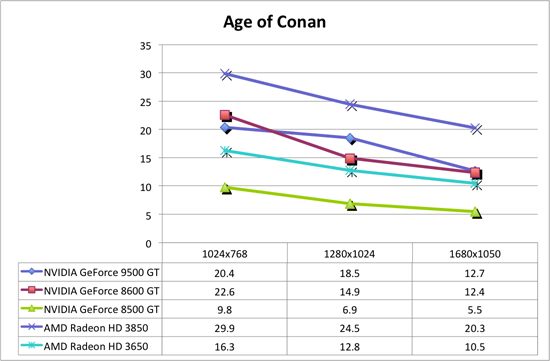
The 3850 offers much higher performance than the rest of the pack for it's higher price. The 9500 GT is neck and neck with the 8600 GT which is as expected. The 3650 lags a bit here even though Age of Conan seemed to really favor ATI hardware when we looked at the 4k series recently.
Crysis
We went with medium quality settings across the board on this, as Crysis really reaches beyond current hardware. As with Age of Conan, though we could play this at the lowest res we tested with the 3850, we would really need to drop to low quality on most options in order to get the framerate up to a comfortable place.
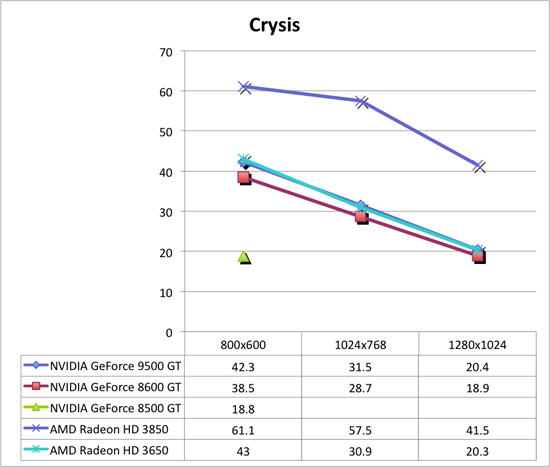
The 9500 GT does lead the 3650, and trades blows with the 8600 GT (which really isn't a surprise). The 3850 does offer a good advantage as well.
The Elder Scrolls IV: Oblivion
Oblivion is getting a little long in the tooth, but it's important to look at it as a baseline. We should expect good performance on this game. And we'll look at the ultra high defaults to see what happens.

We are playable at up to 1024x768 with the 9500 GT with pretty good quality settings. This isn't bad, but it isn't great either. Note that for about $25 more (about 33% more money) you can get a card that gives you more than double the frame rate in oblivion at 1680x1050 and is very playable at that res as well. Value isn't a key factor in these "value" cards is it?
Enemy Territory: Quake Wars
This test is done with everything cranked up except antialiasing.

And we see more of the same.
Race Driver GRID
Once again, high quality settings except for enabling AA.

And one more time: 3850 for not that much more cash blows away the 9500 GT in price performance. Performance of the 8600 GT just trails the 9500 GT. The only twist here is that the 3650 catches up to the 9500 GT at the highest res we tested for a just-less-than-playable frame rate.
Antialiasing Performance
So these cards clearly can't keep up with all the eye candy enabled in most cases. Enabling AA really isn't going to be a reasonable option when you start trading off other important features for it.
Okay, okay, some people really prefer AA to other options. That's fine. I personally tend to favor higher resolution over enabling AA when possible and most features that significantly impact performance have more value to me as well. But AA is one of those things that is very subjective. Some people are more offended by jaggies than others, and some people care less about things like shadows than others. So we'll test a game with some AA and see how it goes. We'll go with Oblivion.
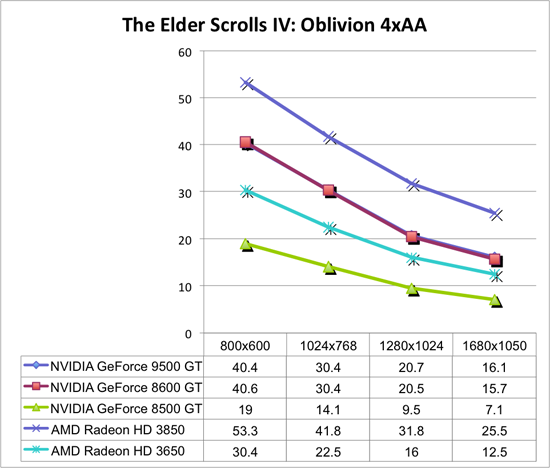
And the story doesn't really change. The 9500 GT mirrors the 8600 GT, the 3850 clearly adds more value than cost, and the 3650 trails behind.
SLI Performance
Yes, we've already seen cases where you can get more than twice the performance for less than twice the price. But a look at SLI is still warranted. For the purposes of this test we'll see if Crysis performance is improved and we'll take another look at Oblivion with and without AA. We are using the same settings we tested with previously.
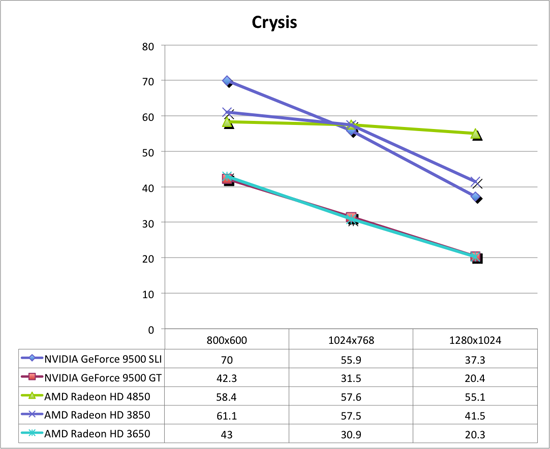
Interestingly, at the low end, the higher end ATI cards top out at about 60 fps. We did disable vsync, but it seems that there is some limitation there keeping these cards from pushing up into higher framerates. The lack of real power in the 9500 GT can be seen at the higher resolutions. For much less money, the 3850 does lead the 9500 GT at resolutions where frame limits don't confuse things.

And here we can really see that the $140 - $160 9500 GT SLI solution struggles to keep up with the $100 3850. And looking at SLI as an upgrade here, we just can't see the value. Down the line, as prices continue to fall, just throwing out the 9500 GT and picking up a 3850 will probably be a better option (if someone doesn't actually decide to bring value to the sub $100 market for a change).
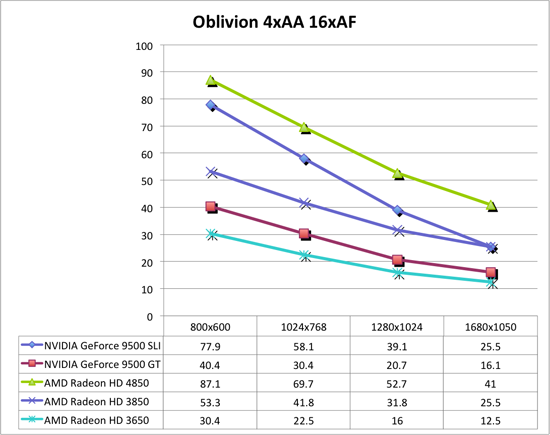
But hey, here's a peak at a spot where 9500 GT SLI actually delivers performance worth what it cost. Performance still drops off faster than other solutions, but it is able to deliver some relevant performance in this case.
Final Words
This is not an exciting launch. The 9500 GT doesn't offer much more performance than the 8600 GT it replaces. The price is okay at between $70 and $80, but the 8600 GT can be had for the same cost as well. While this is a different class of hardware than integrated graphics, these are still just cards for people who aren't invested in playing today's games.
We have gotten used to not expecting much from sub $100 parts. Graphics card companies need to make money, and we can't expect them to give away hardware will killer features and performance. But there are multiple issues with the current state of low end graphics.
Setting the bar too low makes it so that game developers have to put time and energy into targeting crappy hardware. Putting time into making the game work takes away from the time and energy they could available for making the game better. This is a much more difficult than developing for consoles, as their target is relatively high at launch and doesn't change for a good 4 or 5 years. With the current worries over piracy on the PC, we don't need any more difficulty thrown at developers. Giving consumers a reasonable baseline performance for less than $100 is essential to keep game developers interested in and writing for the PC.
Additionally, people who have cheap hardware don't know what they are missing with higher performance parts, but they have no way to experience something that looks good enough to show them why they should care. What we want to see are low end parts that can run all the latest and greatest features that the high end cards can run at reasonable frame rates at very low resolutions. I don't care if it's 640x480 at 30 frames per second, we need hardware that can push through very complex shaders and textures for the good of the PC gaming industry.
It is possible that Larrabee could be a disruptive technology in this market. If Intel is able to deliver a top to bottom launch on day one with volume on all parts, the way graphics hardware is addressed could see a fundamental shift. We might just see the competition realize that they need to change their ways and address the all important low end space with new generations as quickly as possible.
If NVIDIA and AMD can't adjust their strategy for the good of the industry, they might reassess things for the good of their bottom line once a true third competitor comes along in the graphics space. While we still don't know how Larrabee will perform, or even how Intel will approach real desktop graphics, we have a lot of hope that even if this x86 based graphics hardware falls on its face that the competition will not place its hope on Intel's failure.
NVIDIA and AMD need to have a healthy fear and respect for Intel, if only due to the size of their research, development, fabrication, and marketing budgets. The sheer volume of money Intel can pour into this project and not bat an eye is huge. We hope, for their sakes and ours, that NVIDIA and AMD realize this fact.
Who knows, maybe NVIDIA and AMD are already betting on Intel pushing forward with a top to bottom launch of competitive hardware. Maybe they are hard at work on a strategy to improve the quality of the low end hardware they offer and to bring out their parts for a given generation all at once.
And maybe next year we'll see Duke Nukem Forever.
It's nice to dream sometimes ...







